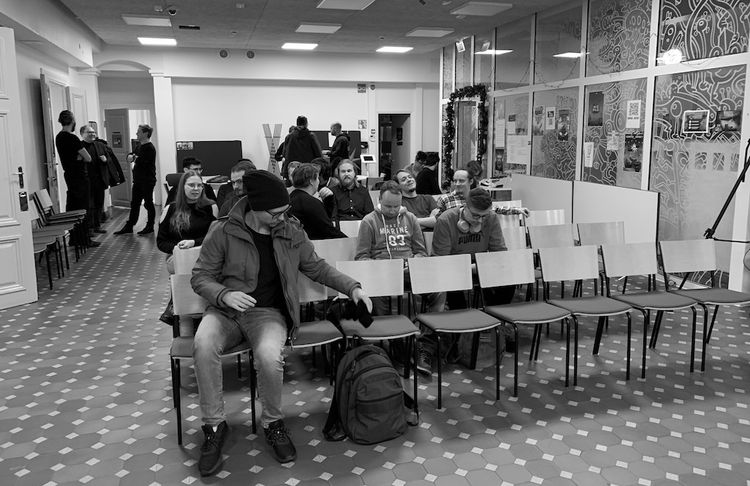EGD News #67 — Keeping the player in mind


Hi there,
It’s Joakim here. Greetings from Helsinki!
As many of you might have already noticed from my LinkedIn update, I’ve now joined Play Ventures as a Venture Partner. I’ve known the founding partners Harri Manninen and Henric Suuronen for ages and it’s a thrill to finally get to work with them. To know more about Play Ventures, you can listen to my interview with Harri from a year back by going here.
You might ask: what is a Venture Partner? And what will happen to my angel investing and Elite Game Developers. Nothing will happen to them, I’ll keep doing both as actively, and possibly even more actively than before. Most of my focus with Play Ventures will be to support their growth and to help with their portfolio companies.
I did write this post on all the details regarding this new role. You can read the post by going here: Joining Play Ventures as Venture Partner
Now, on to this week’s news.
🧑💻 Pitch deck workshop – What didn’t make it into the webinar?
I got many questions after my pitch deck workshop, and I wanted to address three important ones. If you didn’t attend the workshop, you could watch the recording by going here.
First, don’t put your exit strategy into your pitch deck
It signals hurry and short-term thinking. It feels like you’re building for a mid-tier outcome, regardless of the intent.
Mentioning the exit is one of the things that’s better said than put in writing. As founders, it’s essential not to bring it up voluntarily, and only if it’s asked about by an investor, which IMHO would be weird for an investor to ask about in the first place.
The team should focus on one future goal: achieving product-market fit hastily and at all costs.
Second, mind the length
You should be able to communicate everything in 5-10 slides, max. If your pitch deck is 12+ slides, you are providing way too much information.
I see standard slides in decks that people might as well delete, including the Newzoo slide with the games market being a $180bn market. That is obvious so remove it.
And don’t overcommunicate the game. Focus on what matters. If you have a slide dedicated to photos, mockups, or illustrations of the game, you’re not doing an excellent job at keeping things concise. The best I’ve seen is a QR code for Testflight or the App Store to download a test build. Live demos always work.
Third: Be cautious about what investors think about the space you are in
It would help if you did lots of homework when you are working on the company’s idea, on what is an idea that could be venture backable. Meaning that the idea can become a hundred-million dollar business, preferably a billion dollar one.
There are premium PC games investors, but they are relatively small in numbers and are sort-of specialists in the space. And VR and AR games were hyped in 2016, but not so much in 2021.
The question that investors will have: how can this business achieve exponential growth? Going from zero to $50m to $100m in revenue in three years? If you can’t answer that, you’ll need to do more homework.
BONUS — An example of exponential growth game business: You launch a mobile game, where CAC (customer acquisition cost) < LTV (life-time value), and as you increase your acquisition spend, you guarantee that CAC stays at X and LTV stays at X+Y, where Y is a significant and exciting number.
At the early stage, you most likely won’t have proof on CAC < LTV, but you need to show that you are in a space where that is possible, and what your plan and approach will be to achieve this.
Watch the recording and get the workshop slides by going here.
👋 Keeping the player in mind
Rapid prototyping and soft launching are obvious already. Listening to a founder pitch me a game, I always want to understand how they view the market and why the gaming audience needs their game?
When you know the audience and their reasons to play, it’s much better to work backward to what you need to build, whom you need to hire, and how you will validate that you are on the right path as you start the work. You could use the “working backwards” framework, used at Amazon.
When making a game, the developers can often become obsessed with the minutiae of working on a game.
Coders worry about technical debt, designers worry about meta-game systems, artists worry about not pushing the fidelity envelope.
Some work might go into mentioning the target audience, but it’s often brushed aside as wishy-washy work. Perhaps the demographics were defined hastily, “This is a game for 24 to 44-year-old men who like combat games.”
In the age of autonomous teams, anything goes as long as the team gets to decide. How do we make sure that teams are actually building for an end-user in mind?
The easiest and obvious step has been to play your own game. You step into the world of the player and you empathize with the player’s needs. That’s what any outside stakeholder, perhaps an investor, is hoping would happen.
On a high level, how do game studios inject the player mindset into everything it does, from annual reporting to investors, to all-hands planning sessions?
What motivates players?
If we generalize the needs of the players, the core need is that they want to be entertained. The statement you want to hear from a player who played your game is that “It was a lot of fun and I can’t wait to get back to it soon.”
From the definition of fun, if you go down one level deeper, you get to the definition of player motivations. Motivations to play, the core of fun and wanting more of it is the self-determination theory, as explained by Celia Hodent in EGD News 37:
“[Let’s look at] self-determination theory. It explains that we are more likely to be intrinsically motivated to do an activity when this activity satisfies our need for competence, autonomy, and relatedness.”
The three needs of self-determination theory are:
Competence = becoming stronger by learning and developing skills inside the game (mastery)
Autonomy = feeling of control, freedom to make choices (agency)
Relatedness = having meaningful relationships with other people in a game (social dynamics)
The games that satisfies these needs will retain players.
Player personas
To understand players, developers could write out player personas that define the target audience. The core idea with personas is to define what motivates the player persona to engage with the game.
In the “Audience-first game development” webinar from August of 2020, I talked with ex-colleague Mitchell Smallman about game teams utilizing player personas. Mitchell pointed out that “You’ve got your persona and your anti-persona. Both help to define the game you are making.”
Mitchell made a great distinction between Lily’s Garden and Candy Crush. The Lily’s Garden game team could have had this discussion:
Team member 1: “Candy Crush is doing all of this sort of stuff to share what level you’re at. We should take these things from Candy Crush.”
Team member 2: “No, we’re making a non-competitive match3. The competitive player is our anti-persona. We can’t take any of that from Candy Crush, even if it’s working for them, even if it’s popular, because our audience is different by design. We have filtered out those players by not giving them things they like. This is why you should not be afraid to make something that some players don’t like so that you can focus on what your player like. And being able to say that confidently.”
At Next Games, we did company-wide playtests, and to filter out people who were anti-personas, we used Quantic Foundry’s survey to map out our staff so that we could flag the anti-personas.
It’s a team effort
Continuing with Celia Hodent from EGD News 37, explaining the mindset shift user experience (UX) understanding can have on game developers.
“UX is to shift from our perspective as a game developer to adopt the player’s perspective.”
Often tough, the UX person in a games company is only one person, representing the player’s voice. Optimally, the UX person should have the mandate of instilling the mindset of player-centricity into each team member. The UX person then becomes a facilitator of the mindset, brining audience and player persona insights front and center.
At the end of the day, it’s too easy to get caught up in internal politics, busywork and other things that get in the way. Most people forget that a company is ultimately just a team of people who come together to serve the players. It’s nothing more, nothing less.
Frameworks
There’s a few interesting frameworks from outside of gaming, which help tech companies to build better customer understanding.
- The Jobs-to-be-done framework, used at Stripe and Spotify.
- The “working backwards” framework, used at Amazon.
Once the team has immersed their audience in their minds, and the player is present at every discussion, they can figure out all the pitfalls and understand if they’re building something of value to the player. And that’s all that matters. Ultimately, you need to build something of value. The whole goal of a games company is to put out great games that the players love.
🎙 M&A, investments and IPOs in gaming
I recently did a webinar with Anton Gorodetsky and Sergei Evdokimov from InvestGame.net and we reviewed the gaming’s investment, M&A, and IPO landscape from 2020 and shared our predictions on what will happen in gaming during 2021.
Read the full transcript and listen to the episode by going here.
📃 Articles worth reading
+ Ideas That Changed My Life — “You spend years trying to learn new stuff but then look back and realize that maybe like 10 big ideas truly changed how you think and drive most of what you believe.”
+ Scaling and Selling Hyper-Casual Games — “I think there are a whole bundle of metrics beyond this sort of myopic CPI day one, day seven view that a lot of people have that you really need to look at when it comes to investing in a game, a studio, but also to your question, pulling a trigger on a game.”
+ Ad tech companies will become gaming companies in 2021 — “Building ad tech requires a wholly different skillset from building mobile games, and most game developers underestimate the cost of building these systems by a considerable margin (and abandon them when the real costs become clear).”
💬 Quote that I’m thinking about
“It’s not about timing the market, it’s about time in market.”
— Warren Buffett
Sponsored by ironSource
We all know that developing a great game is one thing, but developing a great game business can be something else entirely. That’s why some of the top game developers in the industry use ironSource’s game growth platform, which takes care of both sides of the business, helping you monetize to fuel user acquisition, and vice versa.
From their ROAS Optimizer, the only product on the market built to optimize UA campaigns towards ROAS according to both IAP and ad revenue data, to LevelPlay, their in-app bidding solution, they offer everything you need to supercharge your growth. See for yourself at ironsrc.com
Sponsored by Opera Event
Looking for some great new authentic video creative? Try something totally new with Influencer Generated Content (IGC) by Opera Event. Influencers or actors will make specific creative content for your games and Opera Event will deliver you high-quality video ads that highlight the best parts of your game.
Note! You get a free video with the purchase of 4 or more videos. Remember to say that Elite Game Developers sent you!
Go to www.getigc.com to see some examples and get more information.
That’s all for this week. Take care and stay safe!
Joakim





